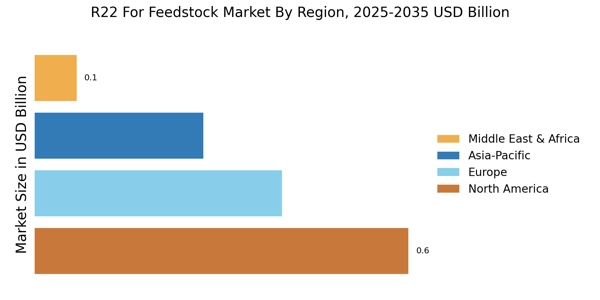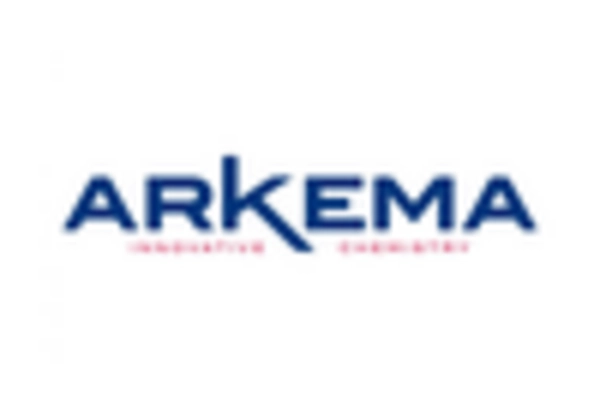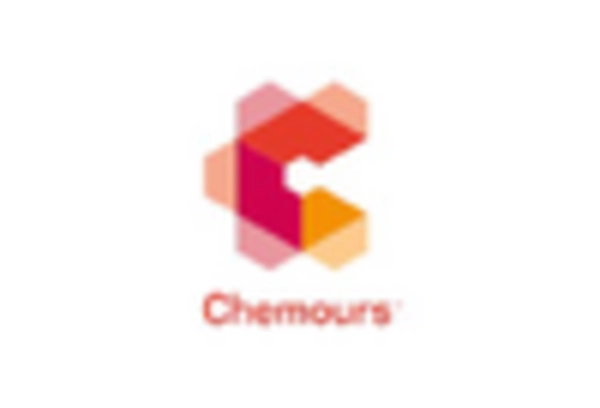Rising Demand from Emerging Economies
The R22 For Feedstock Market is witnessing a surge in demand from emerging economies, where industrialization and urbanization are accelerating. As these regions develop, the need for refrigerants and feedstock materials increases, driving the consumption of R22. For example, countries in Asia and Africa are experiencing rapid growth in sectors such as construction, automotive, and refrigeration, which rely heavily on R22. This trend suggests a potential expansion of the market, as manufacturers seek to meet the rising demand. However, this growth may also prompt scrutiny regarding environmental impacts, leading to a dual focus on meeting demand while adhering to sustainability goals. The interplay between economic growth and environmental responsibility will likely shape the future trajectory of the R22 For Feedstock Market.
Technological Advancements in Production
Technological advancements play a pivotal role in shaping the R22 For Feedstock Market. Innovations in production processes enhance efficiency and reduce costs, making R22 a more viable option for various applications. For instance, improvements in chemical synthesis and purification techniques can lead to higher yields and lower energy consumption. These advancements not only benefit manufacturers but also contribute to the overall sustainability of the industry. As companies adopt cutting-edge technologies, they may gain a competitive edge, allowing them to capture a larger market share. Moreover, the integration of automation and data analytics in production facilities can streamline operations, further driving growth in the R22 For Feedstock Market. The continuous evolution of technology is likely to influence market dynamics, creating a landscape where efficiency and sustainability are paramount.
Consumer Awareness and Sustainability Trends
Consumer awareness regarding environmental issues is reshaping the R22 For Feedstock Market. As individuals and businesses become more conscious of their ecological footprint, there is a growing preference for sustainable products. This shift in consumer behavior is prompting manufacturers to reconsider their offerings, potentially leading to a decline in R22 usage in favor of more eco-friendly alternatives. Companies that proactively address sustainability concerns may find themselves better positioned to capture market share. Furthermore, the rise of green certifications and eco-labels can influence purchasing decisions, making it essential for businesses to align their strategies with consumer expectations. The interplay between consumer awareness and sustainability trends is likely to drive innovation and transformation within the R22 For Feedstock Market.
Market Consolidation and Strategic Partnerships
The R22 For Feedstock Market is experiencing a trend towards consolidation, as companies seek to enhance their competitive positioning. Mergers and acquisitions can lead to increased market share and operational efficiencies, allowing firms to better navigate the complexities of the industry. Additionally, strategic partnerships between manufacturers and suppliers can facilitate access to new technologies and markets. These collaborations may enable companies to innovate more rapidly and respond to changing consumer preferences. As the market evolves, the ability to form effective alliances will likely be a key determinant of success. This consolidation trend may also impact pricing strategies and supply chain dynamics within the R22 For Feedstock Market, as larger entities may exert greater influence over market conditions.
Regulatory Compliance and Environmental Standards
The R22 For Feedstock Market is increasingly influenced by stringent regulatory frameworks aimed at reducing environmental impact. Governments are implementing policies that restrict the use of ozone-depleting substances, including R22. This regulatory pressure compels manufacturers to seek alternatives or invest in technologies that minimize emissions. As a result, the demand for R22 as a feedstock may decline, while the market for compliant substitutes could expand. The industry must navigate these regulations carefully, as non-compliance can lead to significant penalties and reputational damage. Furthermore, the transition towards more sustainable practices is likely to reshape the competitive landscape, pushing companies to innovate and adapt to new standards. This dynamic creates both challenges and opportunities within the R22 For Feedstock Market.


















Leave a Comment